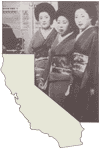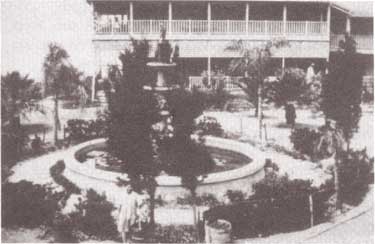![]()

Five Views: An Ethnic Historic Site Survey for California
MENU
Introduction
Immigration
Settlement
Organizations/Religion
Discrimination
World War II Incarceration
Historic Sites
Selected References

A History of Japanese Americans in California:
HISTORIC SITES
White Point
San Pedro, Los Angeles County
White Point is of economic as well as recreational interest with respect to Japanese Americans. Issei immigrants pioneered an abalone fishing industry here in the 1890s, then helped build and use the facilities of a hot springs resort, located here until 1933.
It is believed that two separate groups began abalone fishing here at about the same time. One group consisted of 12 fishermen/farmers, whose members included: Riyojiro Hatashita, Yotaro Hatashita, Sankichi Hatashita, Jinshiro Tani, Takeshiro Higashi, Yoshimatsu Koji, Yoshimatsu Hanamura, Seko, Kishirobei Ryono, Ukichi Kodata, Buntaro Uragami, and Kobei Tatsumi. These issei pioneers were originally employed as laborers by the Southern Pacific Railroad Company. In March 1901, they moved to San Pedro in search of a more profitable, familiar way of life as abalone fishermen.
Around the same time, Japanese immigrants named Seo traveled to the South Bay, establishing an abalone farm at White Point.
Abalone caught during the day were boiled, then dried or canned in the early morning or evening. Dry abalone was sold for about 20 cents a pound, and the shell was sold for four dollars a ton.
Abalone fishing was profitable for about a decade, until outside anti-Japanese propaganda began to affect this issei industry. Los Angeles newspapers wrote that a group of Japanese were spying on the entire Southern California coastline and reporting to the Japanese government. In 1905, the State of California passed legislation prohibiting Japanese Americans from continuing the abalone enterprise. This brought an end to Japanese involvement in the abalone industry at White Point. But discovery, harvesting, and canning of abalone, and identification of fish schools near the coast were important in development of the fishing industry in Southern California. Japanese fishermen subsequently moved from White Point to San Pedro, Terminal Island, and Wilmington.
After the abalone business was abandoned, a seashore spa around the nearby sulphur springs was developed in 1915. Ramon Sepulveda with the help of Tamiji Tagami piped sulphur water into a pool, and built a hotel, a restaurant, and a string of cabins. This was the White Point Health Resort, consisting of sulphur water baths, an Olympic-sized swimming pool, a children's pool, and a sulphur hole. Japanese Americans, who were prohibited from enjoying other hot springs, as well as other people from all parts of California came to enjoy the water and the weather. In the early 1920s, the hot springs, referred to by the Japanese as "onsen," were bustling with many Fujinkai picnics. This was important to the issei, because there were few recreational activities open to Japanese at that time. Even the 1932 Japanese Olympic team made a visit to the hot springs. Then in 1933, the Long Beach earthquake reduced the resort to its foundations. A broken fountain remains at the site of this resort community.

White Point, Los Angeles County [circa 1920]
NEXT> Yamato Colony
Last Modified: Wed, Nov 17 2004 10:00:00 pm PDT
http://www.cr.nps.gov/history/online_books/5views/5views4h101.htm
![]()
 Top
Top